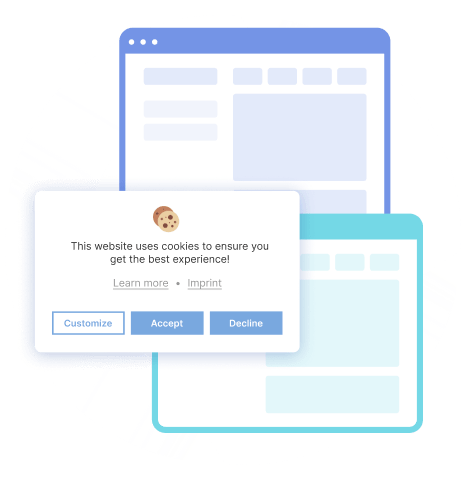Introduction
As the internet continues to evolve, it is important to ensure that privacy laws are being followed on websites across different domains. Obtaining consent for cross-domain cookies has become a crucial aspect of this process. To help website owners and operators navigate this complex landscape, we have created an introductory guide that provides information and best practices for enabling cross-domain consent sharing while remaining in compliance with privacy regulations. With this guide, you can feel confident that you are doing everything necessary to protect the privacy of your users while still delivering the best possible online experience.
Understanding cross-domain consent and its significance
Cross-domain cookie consent refers to the process of collecting and sharing user consent for cookies across multiple domains. When a user visits a website that operates under the same domain group or is linked to other domains, their consent preferences should carry over seamlessly. This practice not only enhances the user experience but also helps website owners respect privacy laws and maintain compliance with regulations such as the General Data Protection Regulation (GDPR) and the California Consumer Privacy Act (CCPA).
The importance of cross-domain consent cannot be overstated. Managing user consent preferences across domains can be challenging for website owners who operate multiple websites or have linked sites. By implementing cross-domain consent, website owners can streamline the user experience and eliminate the need for repetitive consent prompts when users navigate between different websites within the same domain group. Moreover, it builds trust with website visitors by demonstrating a commitment to data privacy and user consent.
Conditions for cross-domain cookie consent from a user side
As a user, it’s important to have control over your privacy when browsing the internet. Cross-domain cookie consent is a necessary step in ensuring that your sensitive information is not accessed by unauthorized third-party websites. Browsers are designed to protect your privacy, so any attempts to bypass this feature are not viable. Obtaining consent from users before collecting any data is crucial for companies to maintain their privacy and security at all times.

What are the legal requirements for cookie consent?
As per GDPR regulations, for instance, people have the authority to provide their consent for modifications made to their personal data for a precise purpose. Websites will exhibit a cookie consent banner to ensure transparency, enabling users to view and review the cookies employed for marketing and advertising objectives. Such measures allow users to make informed choices regarding their privacy on the internet.
The role of consent banners in cross-domain consent
Consent banners play a vital role in obtaining user consent for cookies across multiple domains. When a user visits one domain within a domain group, they are presented with a consent banner that explains the types of cookies used, their purposes, and the ability to customize their consent settings. By enabling cross-domain consent sharing, the user’s consent and preferences are stored in a central database, allowing them to apply across all linked domains or subdomains. This seamless experience enhances user satisfaction and helps website owners maintain compliance with privacy laws.
To successfully enable cross-domain consent sharing and optimize your website’s compliance with privacy laws, consider the following best practices:
Understand your cookie usage and data collection
Prior to implementing cross-domain consent, it is essential to acquire a comprehensive understanding of your website’s cookie usage and data collection practices. In order to achieve this understanding, it is advisable to identify the various types of cookies utilized by your website, including first-party and third-party cookies, along with their respective purposes. This knowledge will empower you to create transparent consent notices and give your website users precise information about the data collection practices employed by your website.
Comply with privacy laws and regulations
It is imperative that you become well-versed in the various privacy laws and regulations that govern data collection and cookie consent. Familiarize yourself with the General Data Protection Regulation (GDPR), the California Privacy Rights Act (CPRA), which amended the CCPA, and any other regional or industry-specific requirements that may apply to your organization. It is crucial to stay up to date with the latest developments in these regulations and ensure that your cross-domain consent practices align with the guidelines outlined in them. By doing so, you can ensure that your data collection and cookie consent practices are compliant and protect the privacy rights of your users.

Implement consent banners across all domains
Consent banners are essential components of cross-domain consent sharing. Implement consent banners on all your websites within the same domain group to provide users with clear and concise information about the cookies used and their purposes. Make sure the banners are easily visible and contain customizable options for users to manage their consent preferences.
Customization is key when it comes to consent banners. Each domain within your domain group may have specific cookie requirements or purposes. Provide users with the ability to customize their consent settings for each domain to ensure a personalized experience. This level of granularity demonstrates your commitment to user privacy and enables users to exercise control over their consent preferences.
Sync consent across devices
Where people use multiple devices to access the internet, it is of utmost importance to synchronize consent across all devices used by an individual. This can be achieved using unique identifiers and consent synchronization mechanisms, which ensure that users’ preferences are applied consistently across all devices. By doing so, users are able to enjoy a highly personalized and seamless privacy experience, which enhances their overall browsing experience. Therefore, it is essential for organizations to prioritize consent synchronization across multiple devices to provide their users with a safe and satisfactory browsing experience.
Conclusion
For website owners who operate multiple websites or linked domains, enabling cross-domain consent sharing is a vital requirement. It helps to enhance the user experience, comply with privacy laws, and build trust with website visitors. To achieve this, it is important to implement best practices and leverage consent banners effectively. Staying updated on privacy regulations and adapting consent management practices accordingly is also crucial.
It is worth noting that prioritizing user consent and privacy goes beyond mere compliance. It fosters positive relationships with website users and enhances their trust in your brand. Implementing cross-domain consent sharing effectively is essential in providing a seamless browsing experience while respecting user preferences and ensuring compliance with privacy laws. Therefore, website owners must pay attention to this crucial aspect of website management.




